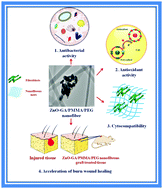Electrospinning nanofibrous graft preparation and wound healing studies using ZnO nanoparticles and glucosamine loaded with poly(methyl methacrylate)/polyethylene glycol†
Abstract
Electrospun nanofibrous scaffolds have attracted a great deal of interest as functional wound dressings. Herein, zinc oxide (ZnO) nanoparticles and glucosamine (GA) serve as a carrier matrix to provide special wound healing characteristics. ZnO nanoparticles and GA-loaded poly(methyl methacrylate) (PMMA)/polyethylene glycol (PEG) nanofibrous grafts have been successfully fabricated using an electrospinning approach to study the synergistic effects to facilitate wound healing. The morphological, optical, and thermal properties of the fabricated nanofibrous grafts have been interpreted using various techniques such as SEM, TEM, AFM, ATR-FTIR, UV-vis-NIR, and DSC. Some of the important properties of the nanofibrous wound dressings, such as porosity, degradation, and drug release, have also been studied. The antimicrobial and antioxidant activities of the prepared grafts have been evaluated by in vitro analysis. The in vitro biocompatibility tests for the nanofibrous grafts were performed using L929 fibroblasts by MTT assay. In vivo studies have been conducted with male albino rats to estimate burn healing activity, and all of the nanofibrous grafts have been shown to increase the acceleration of healing. We, therefore, believe that PMMA/PEG nanofibers incorporated with ZnO nanoparticles and GA may have a synergistic effect on promoting burn wound healing. The ZnO nanoparticles and the GA-modified group stimulate the fibroblasts to produce immature collagen, resulting in faster re-epithelialization compared with the other three nanofibrous grafts. Taken together, these results strongly highlight the potential of these nanofibrous grafts to be adapted for wound dressings for treating burn injuries.



 Please wait while we load your content...
Please wait while we load your content...